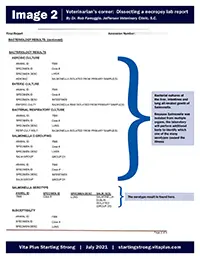
Veterinarian’s corner: Dissecting a necropsy lab report
In this article, Dr. Farruggio explains the various components of the diagnostic report and how he uses that information when working with dairy herds.
 By Dr. Rob Farruggio, Jefferson Veterinary Clinic, S.C.
By Dr. Rob Farruggio, Jefferson Veterinary Clinic, S.C.
After a necropsy is completed at the farm, the veterinarian will prepare any samples and submit them to an accredited diagnostic laboratory. The veterinarian will provide the laboratory with farm information along with specific animal information, including breed, sex, age, and description of clinical signs seen prior to death. All the information given will assist the laboratory in performing the appropriate testing.
The samples will be examined by a staff pathologist over the next several weeks. Once the testing is complete, the laboratory will report any findings to the veterinarian. The veterinarian will then interpret the results, discuss any findings with the client, and propose any necessary changes to treatment protocols or suggest other improvements to reduce further issues.
These results are from a herd that was experiencing a history of increased cases of pneumonia in calves around two months of age. Calves had elevated temperatures, increased breathing rates and no scours present. Antibiotic treatments were not helping and, after several calves died, the owner elected to have a necropsy performed.
Click on the images below to see a sample report along with explanations of the results.
Images 2, 3 and 4 highlight any specific diagnostic tests performed. As you will see on Images 1 and 2, bacteria was isolated on culture, so the laboratory performed an antibiotic susceptibility test by testing the bacteria isolated against commonly used antibiotics to identify which ones should be used in a treatment protocol. The results of the susceptibility test are shown on Image 3.
Please note that the antibiotics are reported using their active ingredient, not the commonly used trade name. Also, this testing is done in a laboratory and not in a live animal, so results and outcomes may not always accurately reflect success. Veterinarians and their clients must also follow all proper drug labels because some antibiotics tested are not approved for all species, ages, or diseases.
In this particular case, all approved antibiotics commonly used are “resistant,” meaning their use would not help any sick calves. Enrofloxacin is “sensitive,” but it can only be used for bovine respiratory disease in dairy cattle less than 20 months of age and its extra-labeled use is prohibited. Herd veterinarians should be consulted in situations like this one.
In cases like this where treatment is limited, steps taken to address the challenge will need to include other options, such as improving the environment through improved cleaning and sanitation. This herd chose this route and, over several months, the presence of Salmonella has been eliminated from a cause of illness.
Polymerase chain reaction (PCR) is used to detect the presence of genetic material from many viruses and bacteria that could be present in the samples submitted. This is another test utilized by the laboratory to assist in identifying the cause of illness. The PCR results are shown on Image 4.
Image 2 (click to enlarge)
Image 3 (click to enlarge)
Image 4 (click to enlarge)
| Category: |
Animal health Starting Strong - Calf Care |





